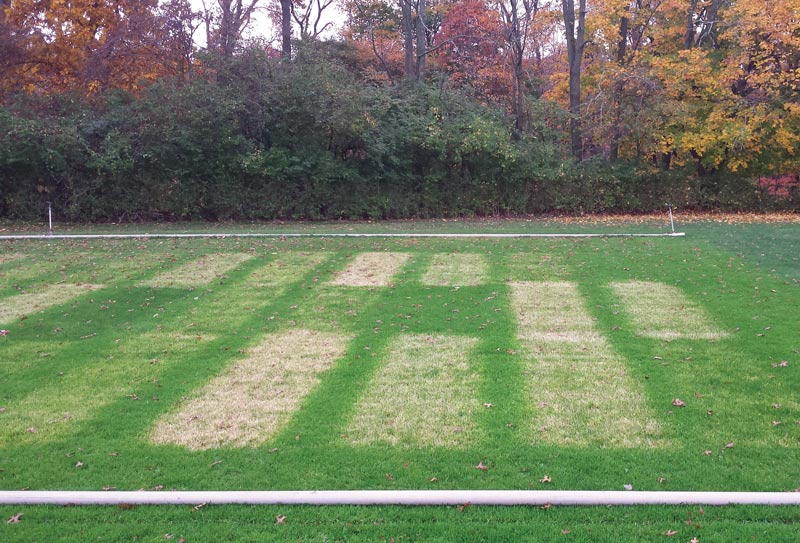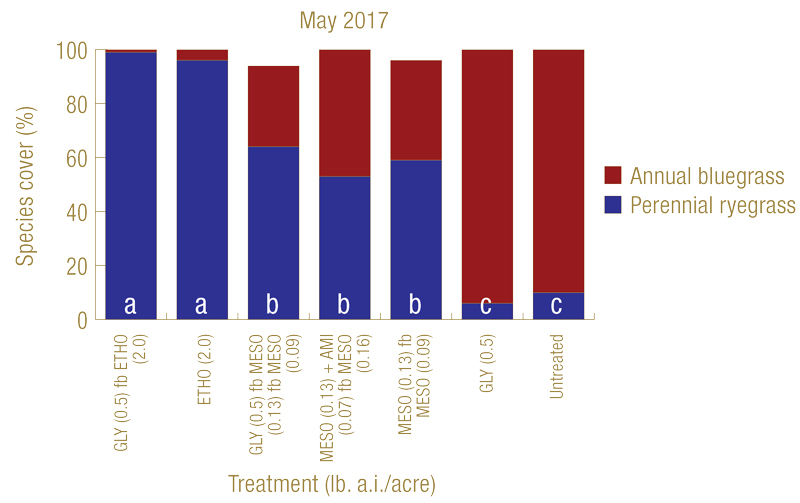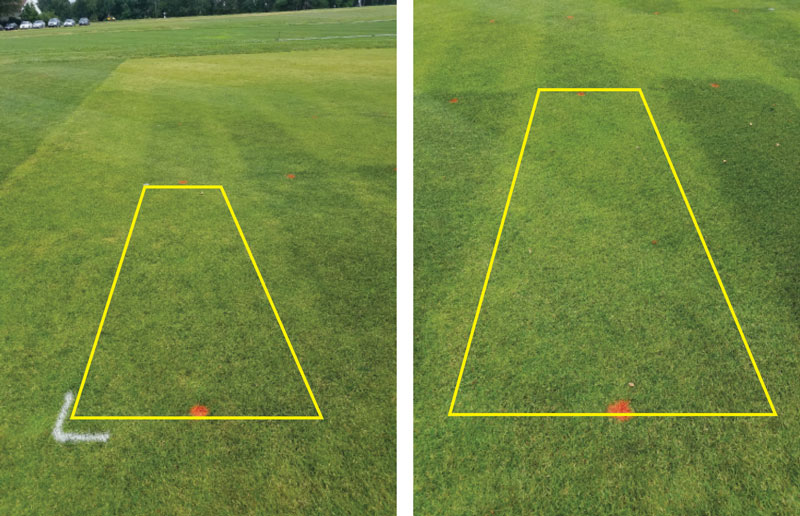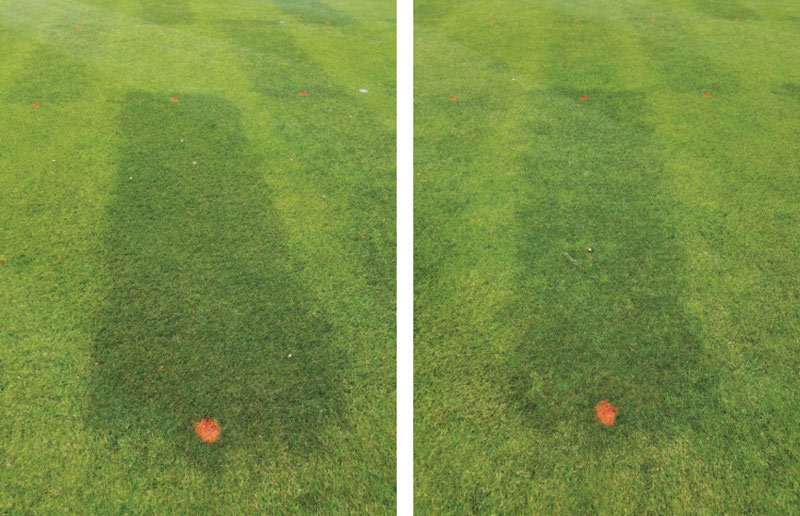
Significant injury (bleaching) to perennial ryegrass and annual bluegrass should be expected following repeat mesotrione applications during autumn. Photo by James Murphy
Annual bluegrass (Poa annua L.) produces large quantities of seed and invades and persists in golf course tees, fairways and roughs. This species exhibits a lack of heat and drought tolerance and is susceptible to numerous disease and insect pests. Annual bluegrass is difficult to control and is generally considered a weed in these golf turf systems.
Researchers have investigated annual bluegrass control with selective herbicide active ingredients such as ethofumesate, mesotrione and amicarbazone in Kentucky bluegrass (Poa pratensis L.) and perennial ryegrass (Lolium perenne L.) turf. Annual bluegrass control with these herbicides can be inconsistent, and often depends on herbicide rate, application timing and frequency.
Turfs that have become severely infested with annual bluegrass can be renovated by applying a nonselective herbicide such as glyphosate and seeding desirable turf species. However, this strategy is not often exercised, as it necessitates closing playing surfaces during the renovation process. One of our research goals was to determine whether selective annual bluegrass control can be combined with seeding a desirable turf species in lieu of nonselectively controlling existing vegetative cover.
Perennial ryegrass can be used effectively to overseed golf course tees, fairways and roughs. In the past, golf course superintendents have been reluctant to establish perennial ryegrass because of its susceptibility to gray leaf spot (caused by Pyricularia grisea [Cooke] Sacc.). More recently, turfgrass breeders have made significant progress in developing perennial ryegrass cultivars that have improved tolerance to gray leaf spot.
Previous research has focused on annual bluegrass control in existing perennial ryegrass turf (3), or the effects of annual bluegrass suppression in renovation scenarios involving seeded Kentucky bluegrass (1). The objective of our research was to assess the effectiveness of herbicide programs designed to maximize perennial ryegrass cover where perennial ryegrass was seeded into an annual bluegrass-infested site.
Research site preparation and perennial ryegrass seeding
Studies were initiated on a naturally infested annual bluegrass location mowed two to three times per week at 0.5 inch (1.3 centimeters) in autumn 2015 and 2016 at Rutgers Hort Farm 2 in North Brunswick, N.J. Annual bluegrass cover in plots was 30% to 49% on Sept. 4, 2015, and 8% to 23% on Sept. 8, 2016; the portion of plots not composed of annual bluegrass was bare soil. The soil was a sandy loam with a soil pH of 5.3 and organic matter content of 2.0%.
The site was core-cultivated on Sept. 14, 2015, and Sept. 16, 2016, using a reciprocating tine unit equipped with 0.625-inch-diameter (1.6-centimeter-diameter) hollow tines set to core to the 3-inch (7.6-centimeter) depth. The tine spacing was 2 × 2 inches (5 × 5 centimeters). Two cultivation passes were made each year perpendicular to each other. Soil cores were reincorporated using a vertical mower.
Manhattan 5 GLR perennial ryegrass was slit-seeded in two directions immediately following cultivation. The final seeding rate was 416 pounds pure live seed/acre (466 kilograms/hectare). A complete fertilizer (16-4-8) was applied at seeding at 27 pounds nitrogen/acre (30 kilograms/hectare) in both 2015 and 2016. Irrigation was supplied as necessary to facilitate perennial ryegrass germination and establishment. After seeding, nitrogen (as 16-4-8) was applied to each trial during autumn to aid in perennial ryegrass establishment. Additionally, each trial was fertilized with nitrogen (as 16-0-8) during the following spring.
Herbicide programs
Herbicide treatments consisted of programs that included KleenUp PRO 4SC (glyphosate), Prograss 1.5EC (ethofumesate), Tenacity 4SC (mesotrione) and Xonerate (amicarbazone) (Table 1). Treatments were: non-treated (no herbicide application); glyphosate only; glyphosate followed by three ethofumesate applications; three ethofumesate applications; glyphosate followed by five mesotrione applications; five mesotrione-only programs; and four different mesotrione + amicarbazone programs. Active ingredient and formulated product rate conversions are provided in Table 1.
Glyphosate, mesotrione + amicarbazone and certain mesotrione treatments were applied 10 days before perennial ryegrass seeding on Sept. 4, 2015, and nine days before perennial ryegrass seeding on Sept. 7, 2016. Other treatments were initiated at and after seeding and continued until Dec. 4, 2015, and Dec. 2, 2016.
Ethofumesate was applied approximately three weeks after perennial ryegrass seeding on Oct. 4, 2015, and Oct. 7, 2016, and sequential applications were made at approximately four weeks (Nov. 3, 2015, and Nov. 4, 2016) and eight weeks (Dec. 4, 2015, and Dec. 2, 2016) after initial applications. Treatment programs discussed in this article are shown in Table 2.
Mesotrione program treatments for annual bluegrass control (pre-emergence and post-emergence) were developed based on previous work that showed that repeat applications of mesotrione can control annual bluegrass (1, 10, 11). The goal of mesotrione + amicarbazone treatments was to achieve post-emergence control of annual bluegrass prior to perennial ryegrass seeding (4); subsequent mesotrione applications were meant to provide pre-emergence and post-emergence control or suppression of annual bluegrass after perennial ryegrass seeding.
Treatments were applied using a CO2-powered backpack sprayer equipped with an AI9506EVS nozzle calibrated to deliver 40 gallons of spray solution/acre. A nonionic surfactant (Activator 90, Loveland Products) was included with all mesotrione treatments at 0.25% (v:v). Treatments were arranged in a randomized complete block design with four replications; plot size was 10 feet × 3 feet (3 meters × 1 meter).
Perennial ryegrass and annual bluegrass cover
Perennial ryegrass and annual bluegrass cover were visually evaluated using a 0 (no cover) to 100 (complete cover) percentage scale in May 2016 and May 2017.

Figure 1. Perennial ryegrass and annual bluegrass cover in May 2016 following perennial ryegrass seeding on Sept. 14, 2015. Glyphosate (GLY) and mesotrione (MESO) + amicarbazone (AMI) were applied 10 days before seeding. Ethofumesate (ETHO) was applied 21, 50 and 79 days after seeding. Mesotrione was applied 33, 37, 40, 44 and 48 days after seeding. Treatments labeled with the same letter are not different.

Figure 2. Perennial ryegrass and annual bluegrass cover in May 2017 following perennial ryegrass seeding on Sept. 16, 2016. Glyphosate (GLY) and mesotrione (MESO) + amicarbazone (AMI) were applied 10 days before seeding. Ethofumesate (ETHO) was applied 21, 50 and 79 days after seeding. Mesotrione was applied 33, 37, 40, 44 and 48 days after seeding. Treatments labeled with the same letter are not different.
Glyphosate only
Perennial ryegrass cover was no different in plots treated only with glyphosate (nonselective control) before seeding than in non-treated plots in either year (Figures 1, 2, above). Where only glyphosate was applied before seeding, perennial ryegrass cover was 15% and annual bluegrass cover was 85% in May 2016, and in May 2017, the same treatment was 6% perennial ryegrass and 94% annual bluegrass. We predicted that applying glyphosate before seeding would increase perennial ryegrass cover compared with non-treated plots; however, the sizable quantity of annual bluegrass seed in the soil seedbank likely explains the failure of this treatment in our study.

Left: Non-treated; perennial ryegrass seeded Sept. 14, 2015. Right: Glyphosate only (0.5 pound a.i./acre), applied Sept. 4, 2015; perennial ryegrass seeded Sept. 14, 2015. Photos by Bradley Park
The poor performance of nonselective herbicide applications before seeding has been observed previously where there is a large annual bluegrass soil seedbank (2); post-emergence herbicide applications following seeding are critical to maximizing establishment of desirable turfgrass species (9).
Ethofumesate programs
Ethofumesate programs after seeding resulted in the greatest perennial ryegrass cover: 94% in May 2016 and 99% in May 2017 (Figures 1, 2). Annual bluegrass populations in these plots were 6% in 2016 and 1% in 2017. We attribute the success of this treatment to the rate of ethofumesate (170 fluid ounces Prograss 1.5EC/acre; 12.4 liters/hectare) and the frequency of application (three times in autumn). Our results resembled those found in earlier research (3) where ethofumesate was applied twice at high-label rates in autumn and achieved 99% control of annual bluegrass. Applying a sufficient quantity of ethofumesate is critical to achieving exceptional annual bluegrass control (7). Researchers have reported lower annual bluegrass control when lower ethofumesate rates were used (10).

Left: Glyphosate (0.5 pound a.i./acre) applied Sept. 4, 2015; perennial ryegrass seeded Sept. 14, 2015; ethofumesate (2.0 pounds a.i./acre) applied 21, 50 and 79 days after perennial ryegrass seeding. Right: Perennial ryegrass seeded Sept. 14, 2015; ethofumesate (2.0 pounds a.i./acre) applied 21, 50 and 79 days after perennial ryegrass seeding. Photos by Bradley Park
Our results indicate that similar levels of perennial ryegrass cover were achieved when ethofumesate was applied either with or without nonselective control of annual bluegrass turf before perennial ryegrass seeding. Thus, nonselective control of existing turf (and closing access to the playing surface) may not be necessary where perennial ryegrass seeding and an effective ethofumesate program are implemented.
Mesotrione and mesotrione + amicarbazone
Mesotrione and mesotrione + amicarbazone programs in autumn resulted in greater perennial ryegrass cover than the glyphosate-only treatment and no treatment (Figures 1, 2). Notably, glyphosate followed by five applications of mesotrione in autumn 2015 resulted in 84% perennial ryegrass cover by May 2016 — a better result than all the other mesotrione programs (Figure 1). However, applying this treatment in autumn 2016 resulted in perennial ryegrass cover similar to that of the other mesotrione programs by May 2017 (Figure 2).
Inconsistent suppression of annual bluegrass by mesotrione has been reported and attributed to temperature, rate and application frequency (5, 10, 11). It should be noted that the Tenacity 4SC label indicates product efficacy for pre-emergence annual bluegrass suppression; there is no provision on the product label for post-emergence annual bluegrass suppression or control (12).
Applying mesotrione + amicarbazone treatments prior to perennial ryegrass seeding provided incomplete control of existing annual bluegrass; annual bluegrass cover remaining in these plots was 11% immediately before perennial ryegrass seeding in 2015, and 28% before seeding in 2016 (data not shown). Mesotrione-based programs that began with a mesotrione + amicarbazone application 10 days before seeding provided perennial ryegrass cover similar to that obtained with programs that applied only mesotrione (Figures 1, 2).
All mesotrione treatments caused injury (bleaching) to plots 48 days after seeding in 2015 and 2016. The severity of injury specific to perennial ryegrass versus annual bluegrass was indistinguishable because of the intensity of bleaching symptoms. Observed bleaching symptoms were consistent with previous reports of mesotrione and similar herbicides causing this type of injury on susceptible turf species, including annual bluegrass (11) and perennial ryegrass (8).
Golf course superintendents should anticipate significant injury (bleaching) of perennial ryegrass and annual bluegrass following repeat applications of mesotrione; severe whitening of foliage may be aesthetically unacceptable to golfers where surfaces remain in play.
Repeat applications of mesotrione may have adversely affected the survival of newly emerged perennial ryegrass seedlings in our research, resulting in lower perennial ryegrass cover and greater annual bluegrass infestation during the following spring. The Tenacity 4SC label indicates that a single application of mesotrione on perennial ryegrass should not exceed 0.16 pound a.i./acre (5.0 fluid ounces Tenacity 4SC/acre; 365 milliliters/hectare) (12). Newly germinated turfgrass should be mowed twice (or four weeks) after emergence before an application is made. Our most application-intensive programs applied mesotrione up to 0.5 pound a.i./acre (16.0 fluid ounces Tenacity 4SC/acre; 1.2 liters/hectare) during a 15-day period beginning 33 days after perennial ryegrass seeding (Table 2).
Moreover, early September core cultivation to prepare the seedbed for turf renovation may have counteracted annual bluegrass suppression provided by mesotrione-based programs. Core cultivation likely brought annual bluegrass seed from the soil bank to the surface immediately before peak annual bluegrass emergence in mid-autumn.
Implications for golf course superintendents
Where annual bluegrass seed in the soil seedbank has led to heavy annual bluegrass infestation in turf, golf course superintendents should not expect application of glyphosate before perennial ryegrass seeding to increase perennial ryegrass cover compared with seeding alone. A post-seeding herbicide program intended to mitigate annual bluegrass encroachment from the soil seedbank is critical during autumn renovations.
Editor’s note: Go inside an Ohio golf club’s decision to transition greens and fairways from annual bluegrass to bentgrass and the many components involved, from shade to PGRs to patience.
Three autumn applications of ethofumesate after seeding resulted in the greatest perennial ryegrass cover by the following May. Superintendents should use caution where ethofumesate is regularly applied for annual bluegrass control, as annual bluegrass resistance to ethofumesate has been reported (6). After establishment, rotating herbicide modes of action and plant growth regulator programs is important to suppress annual bluegrass encroachment and mitigate herbicide resistance in long-term annual bluegrass control programs.
Mesotrione-based herbicide programs applied during autumn resulted in greater perennial ryegrass cover compared with non-treated turf. Significant turf injury (bleaching) was observed with these treatments and may be aesthetically unacceptable for locations that are in play. For post-emergence annual bluegrass control, there was no advantage to making one application of mesotrione + amicarbazone before perennial ryegrass seeding compared with applying mesotrione after seeding. Spring-applied mesotrione + amicarbazone should be considered as part of herbicide mode-of-action rotation programs intended for long-term annual bluegrass suppression.
Mesotrione-based herbicide programs could be more effective in suppressing annual bluegrass in new perennial ryegrass seedings where core cultivation is not used to prepare the seedbed. Moreover, fraze mowing could be useful in harvesting a portion of the annual bluegrass seedbank, although it causes significant surface disruption. Future research evaluating cool-season turfgrass selection and herbicide programming following fraze mowing could help refine and improve these methods.
Funding
We appreciate financial support from the New Jersey Agricultural Experiment Station, Rutgers Center for Turfgrass Science, and New Jersey Turfgrass Foundation.
Acknowledgments
We thank Carrie Mansue for her technical assistance with this research.
The research says ...
- Researchers evaluated herbicide programs for maximizing perennial ryegrass cover where perennial ryegrass was seeded into an annual bluegrass-infested site.
- Glyphosate applied alone before seeding was ineffective.
- Mesotrione-based programs applied in autumn resulted in greater perennial ryegrass cover than no treatment or treatment with only glyphosate; mesotrione programs were inconsistent in controlling annual bluegrass, and they severely bleached the turf.
- When applied at high label rates in autumn, ethofumesate treatments resulted in the greatest perennial ryegrass cover; annual bluegrass resistance to ethofumesate has been reported.
Literature cited
- Baldwin, C., and A.D. Brede. 2010. Minimizing Poa annua invasion during Kentucky bluegrass fairway conversion using mesotrione. ASA, CSSA, SSSA Annual Meetings, Long Beach, Calif. Oct. 31-Nov. 4.
- Branham, B.E., G.A. Hardebeck, J.W. Meyer and Z.J. Reicher. 2004. Turfgrass renovation using dazomet to control the Poa annua L. soil seed bank. HortScience 39:1763-1767 (https://doi.org/10.21273/HORTSCI.39.7.1763).
- Dernoeden, P.H., and T.R. Turner. 1988. Annual bluegrass control and tolerance of Kentucky bluegrass and perennial ryegrass to ethofumesate. HortScience 23:565-567.
- Elmore, M.T., J.T. Brosnan, G.K. Breeden and A.J. Patton. 2013. Mesotrione, topramezone, and amicarbazone combinations for postemergence annual bluegrass (Poa annua) control. Weed Technology 27:596-603 (https://doi.org/10.1614/WT-D-12-00153.1).
- Elmore, M.T., J.T. Brosnan, D.A. Kopsell and G.K. Breeden. 2013. Effects of temperature and nitrogen fertilizer on mesotrione activity against annual bluegrass (Poa annua L.). International Turfgrass Society Research Journal 12:657-661.
- Heap, I.M. 1997. The occurrence of herbicide-resistant weeds worldwide. Pesticide Science 51:235-243 (https://doi.org/10.1002/(SICI)1096-9063(199711)51:3<235::AID-PS649>3.0.CO;2-N).
- Lewis, W.M., and J.M. DiPaola. 1989. Ethofumesate for Poa annua control in bentgrass. In: H. Takatoh, ed. Proceedings of the 6th International Turfgrass Research Conference 6:303-305.
- McCurdy, J.D., J.S. McElroy, D.A. Kopsell, C.E. Sams and J.C. Sorochan. 2008. Effects of mesotrione on perennial ryegrass (Lolium perenne L.) carotenoid concentrations under varying environmental conditions. Journal of Agricultural and Food Chemistry 56:9133-9139 (https://doi.org/10.1021/jf801574u).
- Reicher, Z., M. Sousek, D. Minner and A. Hoiberg. 2014. Summer interseeding and aggressive post-seeding herbicides to reduce annual bluegrass in fairways. USGA Turfgrass Environmental Research Online 13(4):20-22.
- Reicher, Z.J., D.V. Weisenberger, D.E. Morton, B.E. Branham and W. Sharp. 2011. Fall applications of mesotrione for annual bluegrass control in Kentucky bluegrass. Applied Turfgrass Science 8(1)
(https://doi.org/10.1094/ATS-2011-0325-01-RS).
- Skelton, J.J., W. Sharp and B.E. Branham. 2012. Postemergence control of annual bluegrass with mesotrione in Kentucky bluegrass. HortScience 47:522-526 (https://doi.org/10.21273/HORTSCI.47.4.522).
- Syngenta Crop Protection. 2011. Tenacity herbicide label. Syngenta Crop Protection Inc., Greensboro, N.C. p. 16.
Bradley S. Park is a research and outreach agronomist; Matthew T. Elmore is an Extension specialist in weed science for turfgrass, landscapes, pastures and forages; and James A. Murphy is an Extension specialist in turfgrass management at Rutgers University, New Brunswick, N.J.